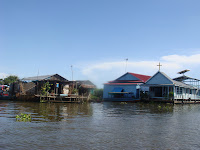When my friend - Dara said that better we go and have a visit to floating village; first that I think - "what; another visit to water village? I've enough of Kampung Air in Sabah" But different country might have different culture.
The ride took us 45 minutes from the city center. Tonle Sap homes to several thousands of mainly Vietnamese fisherman that already have been in this area since the day Vietnam helps to liberate Cambodia from the Pol Pot regime; even before that.
Tonle Sap is interesting due to 2 facts - 1) its flow changes twice a year and 2) the portion of the lake expands and shrinks dramatically with seasons. Its sized 2,700 km² normally and can go up to 16,000 km² during monsoon season with depth of 9 m. Its the most productive inland fisheries in the world, supporting over 3 million people and providing over 75% of Cambodia's annual inland fish catch and 60% of the Cambodians' protein intake.
These families stays in their boats (different from the water village in the Borneo island where they built it on the stilt) where everything else i.e. market, school and even church also built on the pontoons. Their boat well equipped with basic amnesties such as water, electricity and even T.V (I'm sure they even have satellite TV).
The ride took us 45 minutes from the city center. Tonle Sap homes to several thousands of mainly Vietnamese fisherman that already have been in this area since the day Vietnam helps to liberate Cambodia from the Pol Pot regime; even before that.
Tonle Sap is interesting due to 2 facts - 1) its flow changes twice a year and 2) the portion of the lake expands and shrinks dramatically with seasons. Its sized 2,700 km² normally and can go up to 16,000 km² during monsoon season with depth of 9 m. Its the most productive inland fisheries in the world, supporting over 3 million people and providing over 75% of Cambodia's annual inland fish catch and 60% of the Cambodians' protein intake.
These families stays in their boats (different from the water village in the Borneo island where they built it on the stilt) where everything else i.e. market, school and even church also built on the pontoons. Their boat well equipped with basic amnesties such as water, electricity and even T.V (I'm sure they even have satellite TV).
Here, they also faced a similar problem related to the water village as in Malaysia - particularly Sabah : guess what? Immigrants. Some of these Vietnamese are non local and the government had difficulties riding them off. But the good part for the inhabitant of floating village, they do not need to pay any land taxes - jimat duit brother!
From left : primary school on the boat, the floating village
From left : Catholic Church of the floating village, me and my friend - Dara Rann









No comments:
Post a Comment